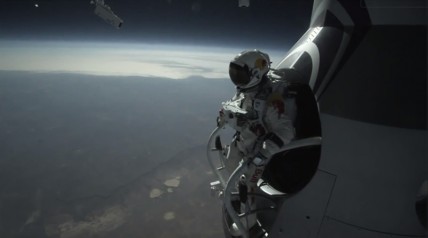
Red Bull Stratos. Still taken from YouTube video of the test jump
Austrian skydiver Felix Baumgartner will attempt to make history early tomorrow morning (AEST) when, weather permitting, he jumps from a capsule at an altitude of 120,000 feet (more than 36km).
All going well, Baumgartner will become the first person to break the speed of sound in free-fall. While not at the technical boundary between the Earth’s atmosphere and space, at 100km of altitude (known as the Kármán Line), Baumgartner’s remarkable feat will still take place in near vacuum.
At roughly 11.30pm tonight (AEST) Baumgartner will ascend in his capsule to the stratosphere pulled upward by a balloon filled with 850,000m3 of helium. If laid flat, the fully inflated balloon would cover more than 40 acres (roughly 160,000m2 ).
The balloon will provide the necessary buoyancy to lift Baumgartner above the previous world record of just under 35km, held by his mentor, retired US Air Force Colonel Joseph Kittinger.
Once at an altitude of 120,000 feet, Baumgartner will exit the ascent capsule and free-fall back towards Earth.
The mission will be streamed live (almost) on various websites, including the Red Bull Stratos site.
Breaking the speed of sound is a challenge for several reasons. As skydivers fall towards Earth, they are accelerated by gravity. But as they speed up, the drag from the surrounding air reduces their acceleration until they reach terminal velocity.
At this point, the drag balances the gravitational (or weight) force, and they can accelerate no more. Due to this limitation, conventional skydivers jumping from altitudes of less than 5km can’t reach speeds greater than 200-300km/h.
But the amount of drag depends on the density of the surrounding air – the more air flowing over the skydiver, the higher the drag. Since Baumgartner will be jumping from much higher in the atmosphere, where the air density is less that 1% of that at ground level, his terminal velocity will be more than 1,000km/h.
In the stratosphere, the speed of sound is approximately 1,100km/h. Will Baumgartner reach this velocity and become supersonic?
Perhaps. The problem is that at such high speeds, more extreme effects will begin to take place.
As Baumgartner approaches the speed of sound, he will experience more and more drag. The air in front of his head will become more compressed as it is no longer able to move as quickly around his body.
At roughly 80% of the speed of sound (or Mach 0.8) shock waves will begin to form around his body as the flow becomes “transonic”. That is, Baumgartner’s body will be surrounded by air currents travelling a range of speeds, from Mach 0.8 to the speed of sound and beyond.
This mixture of flow speeds can result in a loss of control and Baumgartner may be buffeted around due to dramatic changes in pressure.
If he reaches the speed of sound (Mach 1), a bow shock will form in front of his head and in a cone around him. At these speeds, the air in front of Baumgartner cannot avoid his body until it passes through the shock, an extremely thin layer where pressure, temperature and density increase dramatically. At this point, Baumgartner will have truly become supersonic.
Eventually, the drag will balance Baumgartner’s weight and he will reach terminal velocity. If he accelerates past Mach 1.2 Baumgartner will no longer be in transonic flow. The shock will be maintained constantly in the cone around Baumgartner, keeping fairly consistent pressures and no longer being as chaotic.
As long as he keeps all of his limbs within the shock cone, Baumgartner should not experience too much difficulty in continuing to fall supersonically. The increasing drag around Baumgartner – due to the thicker atmosphere closer to the surface – will eventually slow him below the speed of sound as he continues his descent, until eventually he deploys his parachute at subsonic speeds.
The question then becomes, why not jump from even higher? Why not jump from the true edge of space at 100km?
There are several limiting factors to this question. Primarily, it would be practically impossible to build a helium balloon to reach these altitudes.
Just as wood can float on water, so too does helium on air. But at an altitude of 100km the density of air is negligible and there is effectively a vacuum. With no air to hold up the balloon, it would most likely stop much lower in the atmosphere.
But even assuming you could reach an altitude of 100km safely and jump out, other safety factors would become important. A skydiver would require protection from cosmic and solar radiation that the atmosphere protects us from on the surface.
Since the dive would occur from much further out, drag would be negligible for the majority of the fall. This would definitely lead to supersonic speeds upon entry into the denser layers of the atmosphere, probably around Mach 3 (three times the speed of sound).
As the drag builds up lower into the atmosphere, the pressure would increase dramatically and the skydiver’s suit would need strong support to take the high loads off his head and neck.
While these issues will still be felt during Baumgartner’s dive, they will not be as extreme. His suit will definitely need to support his neck and deal with the solar radiation, at least to a minor extent.
It’s probably obvious to say there are dangers with this type of jump. A torn suit would likely result in ebullism, the formation of gas bubbles in bodily fluid that would inflate Baumgartner’s body and render him unconscious within 15 seconds.
Even before this, on the way up, if the balloon ruptures at low altitude it could crash towards Earth before Baumgartner has time to open the escape hatch.
Hopefully everything goes smoothly and a pioneering man attached to a giant balloon will have achieved a new first: to break the sound barrier by jumping from the sky.
By Tristan Vanyai, University of Queensland
Tristan Vanyai does not work for, consult to, own shares in or receive funding from any company or organisation that would benefit from this article, and has no relevant affiliations.![]()




